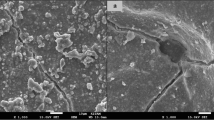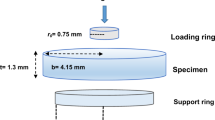Abstract
Objectives
The aim of this study was to examine the long-term effect of heat on the mechanical behaviour of conventional highly viscous glass ionomer cements. Besides, the effect of storage time was evaluated.
Materials and methods
Five cements (ChemFil Rock, Riva Self Cure, Fuji IX GP Fast, Equia and Ketac Molar Aplicap) were evaluated using three different preparation methods: no heat application, application of heat by means of a LED curing unit for 20 and 60 s. Four hundred fifty bar-shaped specimens were produced, maintained in distilled water at 37 °C and tested after 1 week, 1 month and 3 months (n = 10). The Vickers hardness, indentation modulus and creep were measured. In addition, the amount and size of the glass fillers and voids were examined using a light and a scanning electron microscope.
Results
Fuji IX GP Fast showed the highest Vickers hardness, Ketac Molar Aplicap showed the highest indentation modulus and the best value of creep was measured for Riva Self Cure. Vickers hardness, modulus of elasticity and creep resistance increased most for ChemFil Rock and Equia up to 1-month storage.
Conclusions
Heat application showed no effect on the mechanical behaviour of ChemFil Rock, Fuji IX GP Fast and Equia at all ageing time. The impact of storage duration was low.
Clinical relevance
Considering the measured mechanical properties, there is no need of using heat when restoring teeth with glass ionomer cements.

Similar content being viewed by others
References
Talal A, Tanner KE, Billington R, Pearson GJ (2009) Effect of ultrasound on the setting characteristics of glass ionomer cements studied by Fourier transform infrared spectroscopy. J Mater Sci Mater Med 20:405–411
Woolford MJ (1994) Effect of radiant heat on the surface hardness of glass polyalkenoate (ionomer) cement. J Dent 22:360–363
Sidhu SK (2010) Clinical evaluations of resin-modified glass-ionomer restorations. Dent Mater 26:7–12
Wiegand A, Buchalla W, Attin T (2007) Review on fluoride-releasing restorative materials—fluoride release and uptake characteristics, antibacterial activity and influence on caries formation. Dent Mater 23:343–362. doi:10.1016/j.dental.2006.01.022
Mazzaoui SA, Burrow MF, Tyas MJ (2000) Fluoride release from glass ionomer cements and resin composites coated with a dentine adhesive. Dent Mater 16:166–171
Sidhu SK (2011) Glass-ionomer cement restorative materials: a sticky subject? Austr Dent J 56:23–30
Kleverlaan CJ, Van Duinen RNB, Feilzer AJ (2004) Mechanical properties of glass ionomer cements affected by curing methods. Dent Mater 20:45–50
Manhart J, Garcia-Godoy F, Hickel R (2002) Direct posterior restorations: clinical results and new developments. Dent Clin N Am 46:303–339
Manhart J, Chen H, Hamm G, Hickel R (2004) Review of the clinical survival of direct and indirect restorations in posterior teeth of the permanent dentition. Oper Dent 29:481–508
Hickel R, Manhart J (2001) Longevity of restorations in posterior teeth and reasons for failure. J Adhes Dent 3:45–64
Zanata RL, Fagundes TC, Freitas MC, Lauris JR, Navarr MF (2011) Ten-year survival of ART restorations in permanent posterior teeth. Clin Oral Invest 15:265–271
Mahoney E, Kilpatrick N, Johnston T (2008) Restorative paediatric dentistry. In: Cameron AC, Widmer RP (eds) Handbook of pediatric dentistry, 3rd edn. Mosby, Maryland Heights, pp 71–93
Barry TI, Clinton DJ, Wilson AD (1979) The structure of a glass-ionomer cement and its relationship to the setting process. J Dent Res 58:1072–1079
Mount GJ (1999) Glass ionomers: a review of their current status. Oper Dent 24:115–124
Hattab FN, Amin WM (2001) Fluoride release from glass ionomer restorative materials and the effects of surface coating. Biomaterials 22:1449–1458
Frankenberger R, Garcia-Godoy F, Krämer N (2009) Clinical performance of viscous glass ionomer cement in posterior cavities over two years. Int J Dent. doi:10.1155/2009/781462
Algera TJ, Kleverlaan CJ, Prahl-Andersena B, Feilzer AJ (2006) The influence of environmental conditions on the material properties of setting glass-ionomer cements. Dent Mater 22:852–856
Vandewalle KS, Roberts HW, Tiba A, Charlton DG (2005) Thermal emission and curing efficiency of LED and halogen curing lights. Oper Dent 30:257–264
Woolford MJ, Grieve AR (1995) Release of fluoride from glass polyalkenoate (ionomer) cement subjected to radiant heat. J Dent 23:233–237
Carvalho CA, Fagundes TC, Barata TJ, Navarro MF (2008) Influence of ultrasonic setting on microhardness of glass-ionomer cements. J Minim Interv Dent 1:66–76
Yap AUJ, Cheang PHN, Chay PL (2002) Mechanical properties of two restorative reinforced glass–ionomer cements. J Oral Rehabil 29:682–688
O’Brien T, Shoja-Assadi F, Lea SC, Burke FJT, Palin WM (2010) Extrinsic energy sources affect hardness through depth during set of a glass ionomer cement. J Dent 38:490–495
Wahbi MA, Aalam FA, Fatiny FI, Radwan SA, Eshan IY, Al-Samadani KH (2012) Characterization of heat emission of light-curing units. Saudi Dent J 24:91–98
Rueggeberg FA (2011) State-of-the-art: dental photocuring—a review. Dent Mater 27:39–52
Rueggeberg FA, Blalock JS, Callan RS (2005) LED curing lights—what’s new? Compend Contin Educ Dent 26:586–591
Asmussen E, Peutzfeldt A (2005) Temperature rise induced by some light emitting diode and quartz-tungsten-halogen curing units. Eur J Oral Sci 113:96–98
Pérez M, Pérez-Ocón F, Lucena-Martín C, Pulgar R (2008) Stability and reproducibility of radiometric properties of light curing units (LCUs). Part II: LED LCUs. Dent Mater J 27:292–299
Price RB, Felix CA, Andreou P (2005) Evaluation of a dual peak third generation LED curing light. Compend Contin Educ Dent 26:331–347
Algera TJ, Kleverlaan CJ, Gee AJ, Prahl-Andersen B, Feilzer AJ (2005) The influence of accelerating the setting rate by ultrasound or heat on the bond strength of glass ionomers used as orthodontic bracket cements. Eur J Orthod 27:472–476
Coldebella CR, Santos-Pinto L, Zuanon ACC (2011) Effect of ultrasonic excitation on the porosity of glass ionomer cement: a scanning electron microscope evaluation. Microsc Res Tech 74:54–57
Xie D, Brantley WA, Culbertson BM, Wang G (2000) Mechanical properties and microstructures of glass-ionomer cements. Dent Mater 16:129–138
Zoergiebel J, Ilie N (2012) Evaluation of a conventional glass ionomer cement with new zinc formulation: effect of coating, aging and storage agents. Clin Oral Invest. doi:10.1007/s00784-012-0733-1
Palma-Dibb RG, Palma AE, Matson E, Chinelatti MA, Ramos RP (2002) Microhardness of esthetic restorative materials at different depths. Mat Res 6:85–90
Nicholson JW (1998) Chemistry of glass-ionomer cements: a review. Biomaterials 19:485–494
Cattani-Lorente MA, Godin C, Meyer JM (1994) Mechanical behavior of glass ionomer cements affected by long-term storage in water. Dent Mater 10:37–44
Crisp S, Wilson AD (1976) Reactions in glass ionomer cements: V. Effect of incorporating tartaric acid in the cement liquid. J Dent Res 55:1023–1031
Tanner DA, Rushe N, Towler MR (2006) Ultrasonically set glass polyalkenoate cements for orthodontic applications. J Mater Sci Mater Med 17:313–318
Bonifácio CC, Kleverlaan CJ, Raggio DP, Werner A, de Carvalho RC, van Amerongen WE (2009) Physical-mechanical properties of glass ionomer cements indicated for atraumatic restorative treatment. Austr Dent J 54:233–237
Conflict of interest
The authors declare that they have no conflict of interest.
Author information
Authors and Affiliations
Corresponding author
Rights and permissions
About this article
Cite this article
Menne-Happ, U., Ilie, N. Effect of heat application on the mechanical behaviour of glass ionomer cements. Clin Oral Invest 18, 643–650 (2014). https://doi.org/10.1007/s00784-013-1005-4
Received:
Accepted:
Published:
Issue Date:
DOI: https://doi.org/10.1007/s00784-013-1005-4




